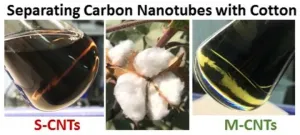MicroMesh: a microscopic polymeric network to attack glioblastoma multiforme
Researchers at Istituto Italiano di Tecnologia in collaboration with Stanford Medicine and the San Raffaele Hospital have demonstrated with preclinical studies the effectiveness of a new biomedical implant for the treatment of glioblastoma multiforme
2021-04-19
(Press-News.org) Genova (Italy), 16th April 2021 - A micro-sized polymeric net wrapping around brain tumors, just like a fishing net around a shoal of fish: this is the microMESH, a new nanomedicine device capable to conform around the surface of tumor masses and efficiently deliver drugs. It has been described by the researchers of the IIT - Istituto Italiano di Tecnologia (Italian Institute of Technology) in Nature Nanotechnology. The new biomedical implant has been validated in preclinical studies that demonstrate its effectiveness for the treatment of glioblastoma multiforme.
This work has been carried out by the group of Prof. Paolo Decuzzi, head of the IIT Laboratory of Nanotechnology for Precision Medicine, in collaboration with the Neural Stem Cell Biology Laboratory of Dr. Rossella Galli at the San Raffaele Hospital in Milan and the group of Prof. Gerald Grant at the Lucile Packard Children's Hospital of Stanford University. The study was originated within the research activities conducted by Decuzzi in the context of projects supported by the European Research Council and the Marie Sk?odowska-Curie Action program.
Although they are quite rare, brain tumors are among the most aggressive and difficult to cure. In particular, glioblastoma multiforme is the tumor with the most severe prognosis: the average survival is just over 12 months and only 5% of the patients survive beyond 5 years. Glioblastoma multiforme typically affects men and women between 45 and 75 years of age. Furthermore, unlike other malignancies, there has been no significant diagnostic and therapeutic improvements for this malignancy over the past 30 years. In fact, both the incidence of new cases and the number of deaths has remained practically unchanged. The only therapeutic strategy currently used is based on surgery, which consists of removing a part of the tumor mass and reducing intracranial pressure, followed by radiotherapy and/or chemotherapy.
The biomedical system developed by IIT and its collaborators can play a very important role in the fight against the disease, representing a possible effective alternative to the few pharmacological treatments used to date.
The microMESH has the shape of a micrometric polymeric net, it is made with biodegradable materials and wraps around the tumor mass. In fact, the micrometric thick polymeric fibers are very flexible and are arranged to form regular openings, which are also micrometric, just like the size of cancer cells. This unique feature allows the microMESH to achieve a closer interaction with the tumor mass, increasing the therapeutic efficacy. Its structure consists of two separate compartments in which different drugs can be loaded which are released towards the tumor mass in an independent, precise, and prolonged fashion. The microMESH can 'attack' glioblastoma by combining different therapies: chemotherapy, nanomedicine, and immunotherapy.
Prof. Paolo Decuzzi and his collaborators, in particular Daniele Di Mascolo and Anna Lisa Palange, will continue to develop the microMESH by integrating different types of drugs and therapies to tackle other types of tumors. In the short term, their major objective will be to validate the technology on glioblastoma patients.
INFORMATION:
[Attachments] See images for this press release:

ELSE PRESS RELEASES FROM THIS DATE:
2021-04-19
The prevalence of intellectual disabilities, which means difficulties with learning and understanding new things, is roughly 1-2% in the population. People with a severe intellectual disability need help from others in daily activities throughout their lives.
Such disabilities can be caused by genetic changes or external factors. According to estimates, roughly 2,500 genes underlie intellectual disability, of which approximately half remain unidentified.
In recent years, the diagnostics for intellectual disabilities have improved thanks to advancements in techniques that make it possible ...
2021-04-19
Language is one of the most notable abilities humans have. It allows us to express complex meanings and transmit knowledge from generation to generation. An important question in human biology is how this ability ended up being developed, and researchers from the universities of Barcelona, Cologne and Tokyo have treated this issue in a recent article.
Published in the journal Trends in Cognitive Sciences, the article counts on the participation of the experts from the Institute of Complex Systems of the UB (UBICS) Thomas O'Rourke and Pedro Tiago Martins, led by Cedric Boeckx, ICREA research professor at the Faculty of Philology ...
2021-04-19
In December 2019, a new viral infection was detected in Wuhan, China. On January 30, 2020, the World Health Organization declared the outbreak a public health emergency of international concern, and on March 11, the COVID-19 pandemic. In light of the danger that the infection poses to human personnel, the idea to utilize automation in hospitals is one of the natural solutions in healthcare.
Among the paper's five co-authors, four are working in robotics and one is an expert in medicine. The paper presents a new concept of an infectious hospital that may become a worldwide standard in the future. The idea of this appeared while the authors ...
2021-04-19
While studying strontium titanate with electron paramagnetic resonance, a team from KFU's Center for Quantum Technology has found that the shape of a specimen of strontium titanate influences its internal symmetry. The research was co-conducted by the Ioffe Institute of Physics and Technology (Russia) and the Institute of Physics of the Czech Academy of Sciences.
At room temperature, SrTiO3 is a crystal with high cubic symmetry, that is, the lattice of strontium titanate, like bricks, is composed of unit cells, each of which is a regular cube. However, the researchers showed the picture is a bit more nuanced. In ...
2021-04-19
The research is conducted by Kazan University's Open Lab Gene and Cell Technologies (Center for Precision and Regenerative Medicine, Institute of Fundamental Medicine and Biology) and Republic Clinical Hospital of Kazan. Lead Research Associate Yana Mukhamedshina serves as project head.
Spinal cord injury mechanisms include primary and secondary injury factors. Primary injury is mechanical damage to the nervous tissue and vasculature with immediate cell death and hemorrhage. Secondary damage leads to significant destructive changes in the nervous tissue due to the development of excitotoxicity, death ...
2021-04-19
The project was kickstarted in 2017 when a delegation of YTC America (subsidiary of Yazaki Corporation) visited Kazan Federal University. During the talks, YTC suggested that KFU participate in developing effective methods of separating single-wall carbon nanotubes (SWCNTs) into metallic and semiconducting specimens. This was to be done on Tuball tubes produced by OCSiAl, since they are the only ones currently available in industrial quantities.
Carbon nanotubes (CNT) is a family of 1D nanostructures with numerous verified applications, made possible due to their ...
2021-04-19
A recent study finds that social inequality persists, regardless of educational achievement - particularly for men.
"Education is not the equalizer that many people think it is," says Anna Manzoni, author of the study and an associate professor of sociology at North Carolina State University.
The study aimed to determine the extent to which a parent's social status gives an advantage to their children. The research used the educational achievements of parents as a proxy for social status, and looked at the earnings of adult children as a proxy for professional success.
To ...
2021-04-19
ADELPHI, Md. -- Spoken dialogue is the most natural way for people to interact with complex autonomous agents such as robots. Future Army operational environments will require technology that allows artificial intelligent agents to understand and carry out commands and interact with them as teammates.
Researchers from the U.S. Army Combat Capabilities Development Command, known as DEVCOM, Army Research Laboratory and the University of Southern California's Institute for Creative Technologies, a Department of Defense-sponsored University Affiliated Research Center, created an approach to flexibly interpret and respond to Soldier intent derived from spoken dialogue with autonomous systems.
This technology is currently the primary ...
2021-04-19
The Andes Mountains of South America are the most species-rich biodiversity hotspot for plant and vertebrate species in the world. But the forest that climbs up this mountain range provides another important service to humanity.
Andean forests are helping to protect the planet by acting as a carbon sink, absorbing carbon dioxide and keeping some of this climate-altering gas out of circulation, according to new research published in Nature Communications.
The study -- which draws upon two decades of data from 119 forest-monitoring plots in Colombia, Ecuador, Peru, Bolivia and Argentina -- was produced by an international team of scientists including researchers supported by the Living Earth Collaborative at Washington University in St. Louis. The lead author was Alvaro Duque from the ...
2021-04-19
A team of scientists from Russia studied the role of double-stranded fragments of the maturing RNA and showed that the interaction between distant parts of the RNA can regulate gene expression. The research was published in Nature Communications.
At school, we learn that DNA is double-stranded and RNA is single-stranded, but that is not entirely true. Scientists have encountered many cases of RNA forming a double-stranded (a.k.a. secondary) structure that plays an important role in the functioning of RNA molecules. These structures are involved in the regulation of gene expression, where the double-stranded regions typically carry specific functions and, if lost, may cause severe disorders. A double-stranded structure is created by sticky complementary ...
LAST 30 PRESS RELEASES:
[Press-News.org] MicroMesh: a microscopic polymeric network to attack glioblastoma multiforme
Researchers at Istituto Italiano di Tecnologia in collaboration with Stanford Medicine and the San Raffaele Hospital have demonstrated with preclinical studies the effectiveness of a new biomedical implant for the treatment of glioblastoma multiforme







